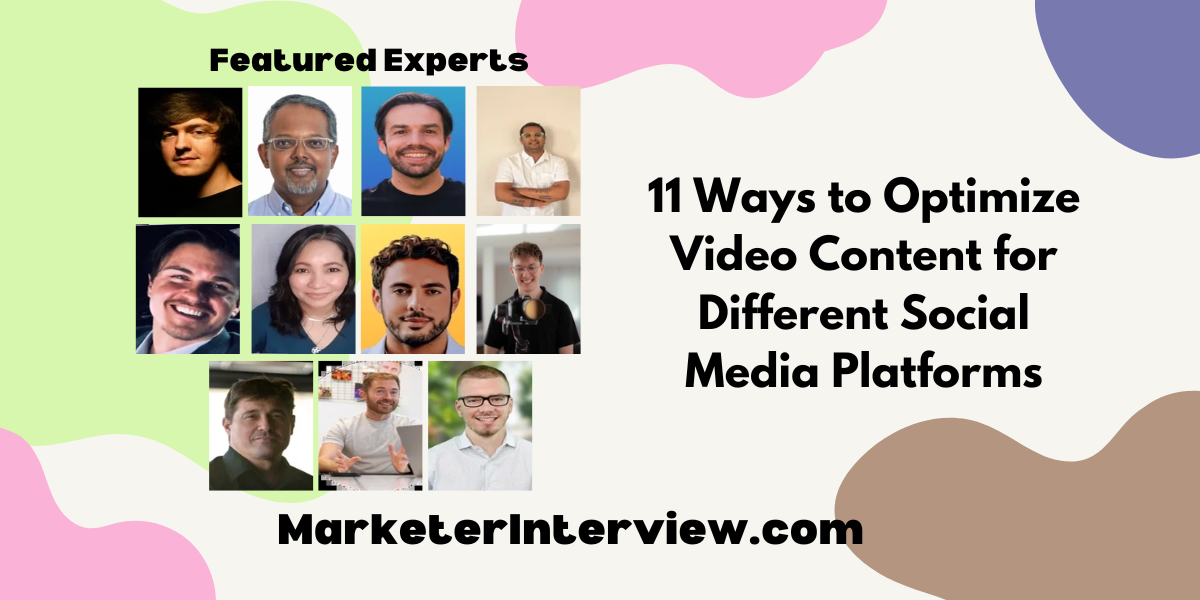11 Ways to Optimize Video Content for Different Social Media Platforms
In the fast-paced world of social media, optimizing video content is crucial for engagement and reach. We’ve gathered insights from eleven industry experts, including Executive Producers and CEOs, to share their best tips. From customizing video aspect ratios to maintaining brand consistency in your videos, discover the spectrum of strategies to elevate your social media presence.
Want to get quoted in MarketerInterview.com content just like this? Apply to become a contributor today!
Contents
- 1 Customize Video Aspect Ratios
- 2 Utilize Double-Frame Shooting
- 3 Analyze Top Creators’ Techniques
- 4 Adapt Video Length and Format
- 5 Leverage Interactive Features for Engagement
- 6 Match Content to Platform Behavior
- 7 Engage Audience with User-Generated Content
- 8 Include Closed Captions and Transcripts
- 9 Keep Videos Concise
- 10 Tailor Content to Platform Strengths
- 11 Maintain Brand Consistency in Videos
Customize Video Aspect Ratios
One specific tip is to tailor the video’s aspect ratio and length to match the platform’s best practices. For example, Instagram favors square or vertical videos, while YouTube and Facebook prefer horizontal formats.
Also, creating attention-grabbing thumbnails and adding captions can enhance accessibility and engagement across various platforms. You can maximize your visibility and impact by customizing your video content to align with each platform’s unique specifications.

Jared Floyd, Executive Producer, Ajax Creative
Utilize Double-Frame Shooting
When framing a shot, turn on double-frame guidelines on your camera/video monitors, 16:9 and 9:16, or use 1:1 frame lines and shoot your subject wider, placed in the middle of the frame with correct headroom. This allows you the option to export the video correctly for multiple social media platforms as needed later.

Senthil M, Founder/Cinematographer, t-eight
Analyze Top Creators’ Techniques
Study the creators and influencers who reach the most people with their video content. If you’re looking to grow on Instagram, find top influencers who create video content in your niche.
Study what makes their videos so great, share that with your video editor, and ask them to take it into account when creating and editing your Instagram video content.
Apply the same technique to all social channels you’re active on. Each channel is unique, so don’t just copy and paste your IG video to X. Edit and customize for every channel.

Connor Gillivan, Entrepreneur, Owner & CMO, TrioSEO
Adapt Video Length and Format
Tailor your video length and format to fit the platform. For example, on Instagram, keep videos under 60 seconds and utilize a vertical format for Stories and Reels. On YouTube, longer, more in-depth content works best, so aim for 10-15 minutes.
TikTok thrives on ultra-short, engaging clips of 15-60 seconds, often with trending music or effects. By adapting to each platform’s preferred style and length, you can maximize engagement and ensure your content resonates with the audience effectively.

Bhavik Sarkhedi, CMO, Write Right
Leverage Interactive Features for Engagement
One specific tip for optimizing video content for different social media platforms is to adjust the video format and length to match each platform’s unique audience behavior. For example, on Instagram and TikTok, short vertical videos (9:16) of 15-30 seconds perform exceptionally well because they take advantage of the entire mobile screen and cater to users’ quick consumption habits. At Cleartail Marketing, we switched a client’s promotional videos to this format and saw a 28% increase in viewer engagement on Instagram Stories.
Another technique I rely on is leveraging platform-specific interactive features. On Instagram, using elements like polls, questions, and the ‘Swipe Up’ feature in Stories can significantly enhance user interaction. For instance, we implemented these features for a client’s product launch and observed a 20% increase in direct messages and product inquiries. These interaction points not only boost engagement but also drive traffic and conversions.
Lastly, ensuring your video thumbnails and titles are tailored for each platform can make a substantial difference. Thumbnails should be compelling and aligned with the platform’s aesthetic to capture attention. For a recent client project, I customized video thumbnails using bold, clear text and engaging visuals on YouTube, which resulted in a 15% increase in video views. A well-crafted thumbnail acts as a gateway, enticing users to click and watch your content.

Magee Clegg, CEO, Cleartail Marketing
Match Content to Platform Behavior
One specific tip for optimizing video content for different social media platforms is to tailor the video’s aspect ratio and length according to each platform’s unique requirements and user behavior. For example, on Instagram and TikTok, vertical (9:16) videos are crucial as they fill the entire screen and provide an immersive experience. When working with a client in the health and fitness industry, we switched their promos to vertical format and saw a 28% increase in viewer engagement compared to horizontal videos.
Another technique is leveraging platform-specific features to enhance user interaction. For instance, on Instagram, using interactive elements like polls, questions, and the “Swipe Up” feature in Stories can boost engagement significantly. We implemented these elements for a clothing brand, and the interactive stickers led to a 20% uptick in direct messages and product inquiries, indicating higher user interest and interaction.
Additionally, customizing content length can vastly improve viewer retention. Short, snappy clips of 15-30 seconds work best for platforms like TikTok and Instagram Stories, while videos ranging from 7 to 15 minutes perform well on YouTube, where audiences expect more detailed content. For a tech startup, we adjusted our YouTube content to longer, more in-depth product reviews, resulting in a 30% increase in viewer retention and watch time. Tailoring video length to match platform consumption habits ensures higher engagement and viewer satisfaction.

Haiko de Poel, Owner, Mass Impact
Engage Audience with User-Generated Content
One specific tip for optimizing video content for different social media platforms is to leverage user-generated content (UGC). At MBC Group, we encourage our clients to create branded hashtags and invite their followers to share videos using their products. For example, one of our campaigns saw a 30% increase in engagement when users posted their own testimonials on Instagram using the hashtag we provided. This not only increased brand visibility but also built a sense of community and trust among followers.
Another technique is to consistently maintain high video quality and tailor the aspect ratio to the platform’s specifications. For instance, we’ve seen greater viewer retention rates on Instagram Stories and TikTok by creating vertical (9:16) videos, which feel more natural and engaging on mobile devices. Conversely, on LinkedIn and Facebook, square (1:1) or horizontal (16:9) videos tended to perform better. During a recent campaign, adjusting our video formats led to a 25% increase in viewer engagement on Facebook and a noticeable rise in click-through rates.
Lastly, incorporating platform-specific features like AR filters or interactive polls can significantly boost engagement. For a product launch on Instagram, we used AR filters that allowed users to visualize the product in their environment, resulting in a remarkable 17% uptick in product inquiries. Utilizing each platform’s unique tools not only makes the content more engaging but also drives better interaction and conversions.

Matthew Montez, Founder, The MBC Group
Include Closed Captions and Transcripts
One specific tip for optimizing video content for different social media platforms is to include closed captions and transcripts. Adding captions to your videos not only makes them accessible to the deaf and hard of hearing but also enhances the overall user experience. For example, at BetterWeb.ai, incorporating closed captions for a client’s promotional video resulted in a 40% increase in viewer engagement and a 53% rise in mobile traffic, as users could watch the video in various environments without needing sound.
Providing transcripts for audio content is another great way to improve accessibility and SEO. This approach benefits not only individuals who prefer reading over listening but also enhances search engine indexing. At BetterWeb.ai, we saw a significant uptick in organic search traffic after implementing detailed transcripts for a series of educational webinars. This not only broadened our content’s reach but also made it easier for users to find relevant information through search engines.
Additionally, ensuring that multimedia elements are keyboard-accessible can vastly improve the overall accessibility of your content. We developed a feature allowing seamless keyboard navigation through videos and interactive elements, which greatly improved the user experience for those using assistive technologies. By paying attention to these details, we’ve been able to create more inclusive content, leading to higher engagement and better user satisfaction across varied platforms.

Guy Leon, Founder & CEO, betterweb.ai
Keep Videos Concise
Today, social media is considered the number one marketing tool, not just by marketers alone, but by business experts as well. Why? Because everybody has at least one active social media account across the many platforms available. However, as a digital marketer, I have discovered that it is one thing to be aware of the marketing advantages that come with social media and easy engagements with video content, and something else to be able to effectively leverage this opportunity across multiple platforms.
You see, when it comes to optimizing video content for different social media platforms, one thing I never fail to consider is video length. Yes, videos are impactful, but the truth is that they can quickly become boring for your audience when they take too long to get to the point, and this is a bad thing because today’s audience generally does not have the patience to consume lengthy content.
Hence, one effective way I have found to optimize video content on social media platforms is to condense a lot of information into short videos.

Edmafe Eclavea, Marketing Manager, Couponsnake
Tailor Content to Platform Strengths
One specific tip for optimizing video content for different social media platforms is to leverage the strengths of each channel’s format and user behavior. For instance, I’ve found tremendous success in tailoring content length to specific platforms. On Instagram Stories and TikTok, short, engaging clips of 15-30 seconds perform exceptionally well because they align with the quick-consumption behavior of users. In contrast, YouTube thrives on longer, in-depth videos ranging from 7 to 15 minutes. Implementing this strategy at my previous software and marketing startup led to a 25% increase in viewer retention on YouTube and higher engagement rates on Instagram Stories.
Repurposing content effectively is another technique I’ve utilized. For example, a comprehensive blog post can be broken down into bite-sized video segments for Instagram Stories, a detailed video tutorial for YouTube, and an engaging GIF or teaser for Twitter. This diversified approach not only maximizes the reach of the original content but also caters to the unique consumption habits of each audience. When we applied this strategy at Anthem Software, we saw a significant uptick in audience engagement, with certain repurposed videos attracting 20% more views compared to original formats.
Lastly, incorporating platform-specific interactive features can dramatically boost user engagement. On Instagram, using stickers, polls, and ‘Swipe Up’ features in Stories can drive immediate interactions. I’ve observed a 17% increase in user engagement when integrating these features into marketing campaigns. Similarly, Facebook’s live videos and interactive elements like comments and reactions can enhance real-time engagement. Using these platform-specific tools, we were able to create a more interactive and dynamic user experience, keeping our audience more engaged and driving higher conversion rates.

Joe Amaral, Founder & COO, Anthem Software
Maintain Brand Consistency in Videos
Stay true to your brand. Especially with TikTok, we mostly get asked to produce content that has nothing to do with the brand identity itself. Picking up trends is a good way of boosting views in the short term; but if you want to leave an impression, don’t water down your identity for short-term success. Always try to either entertain or provide value while staying on brand.

Damian Ruchti, Founder, Kordial
Want to get quoted in MarketerInterview.com content just like this? Apply to become a contributor today!






